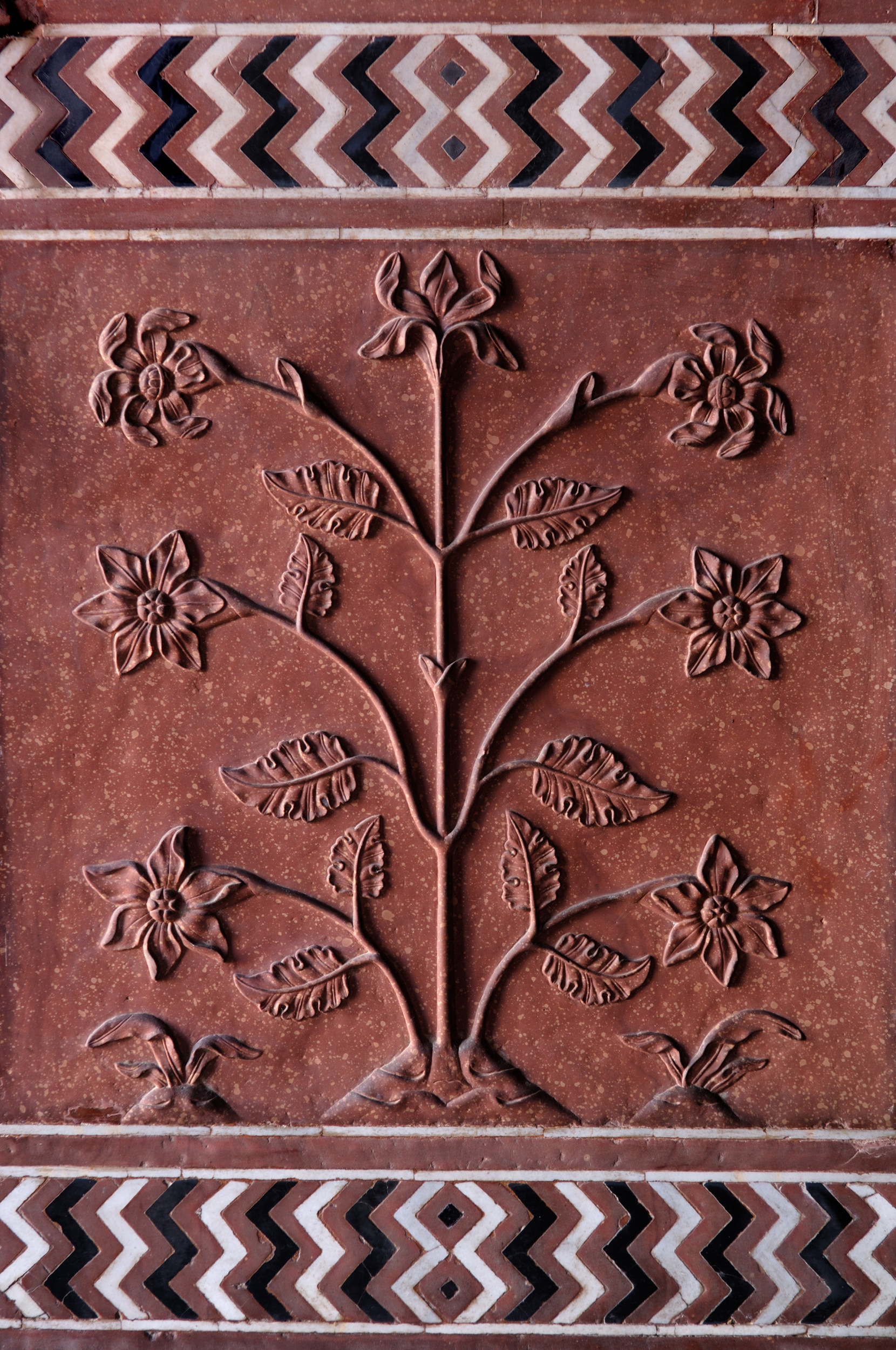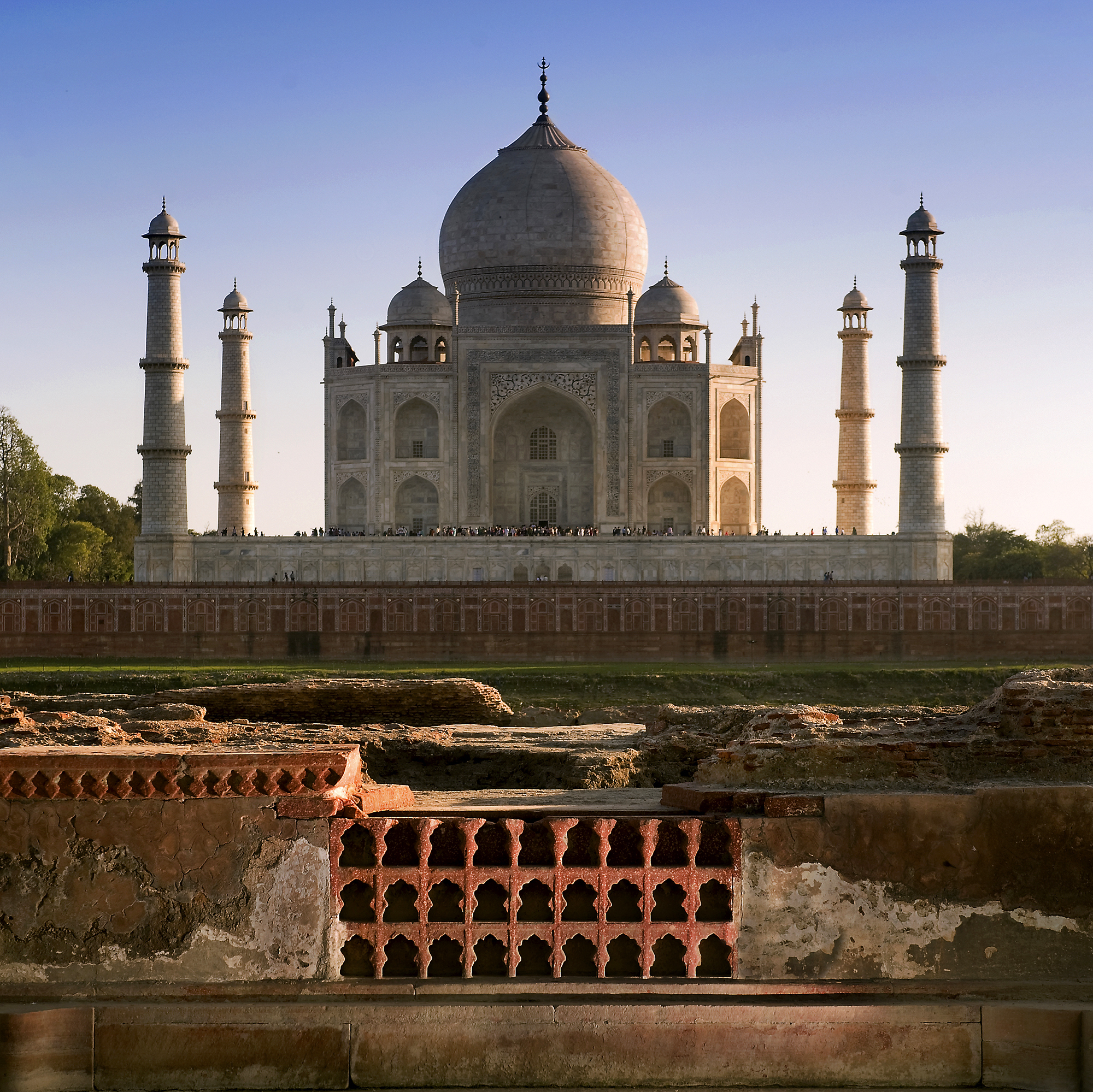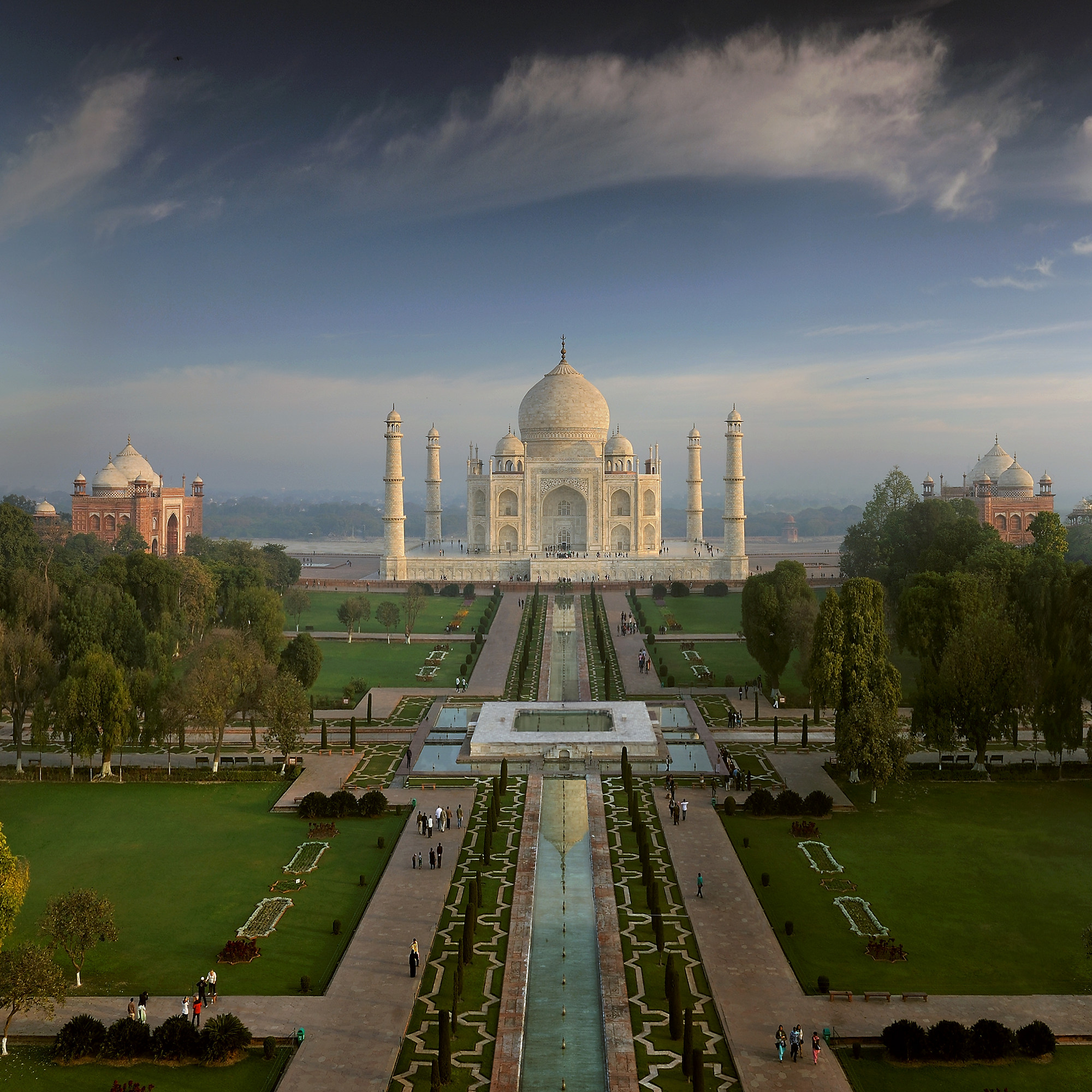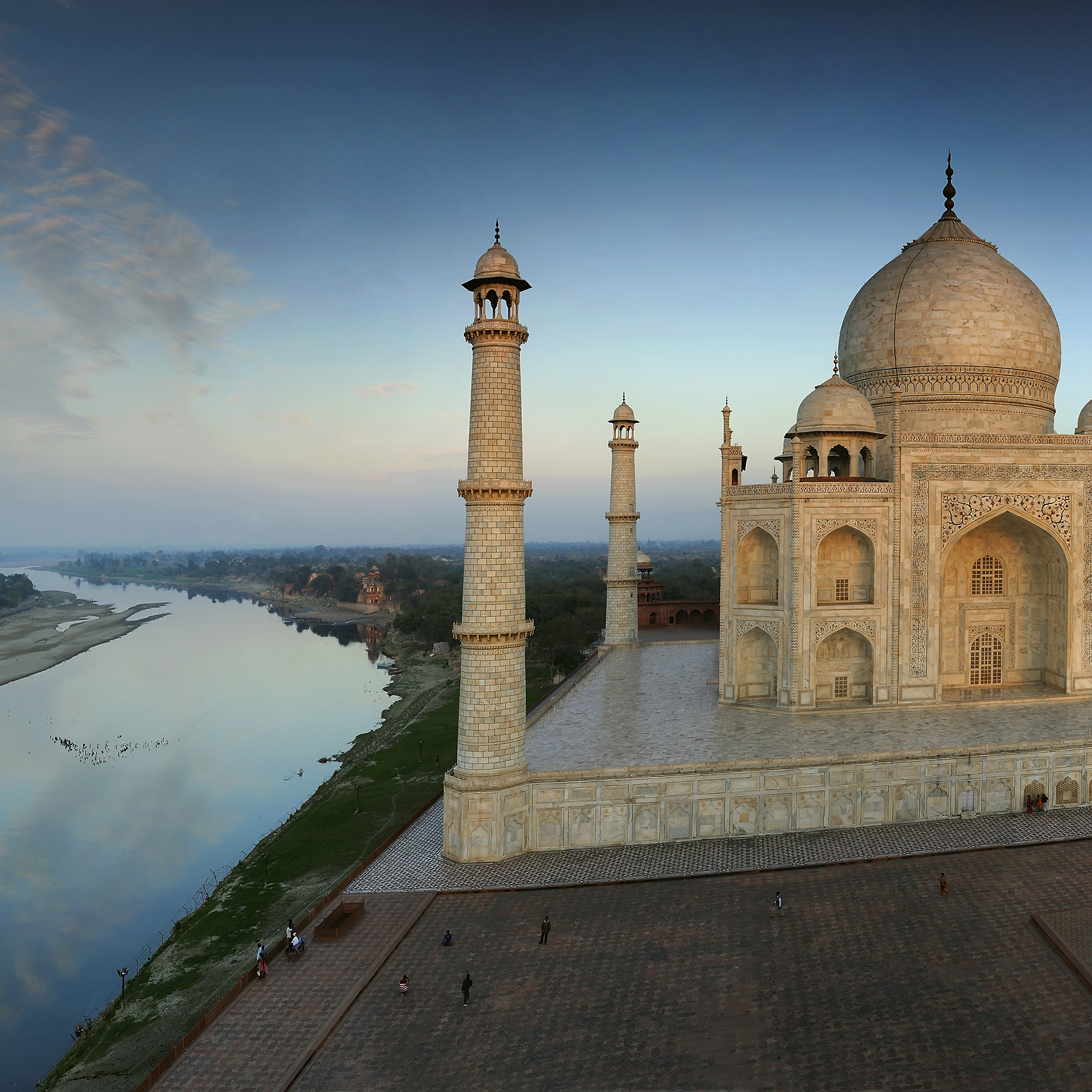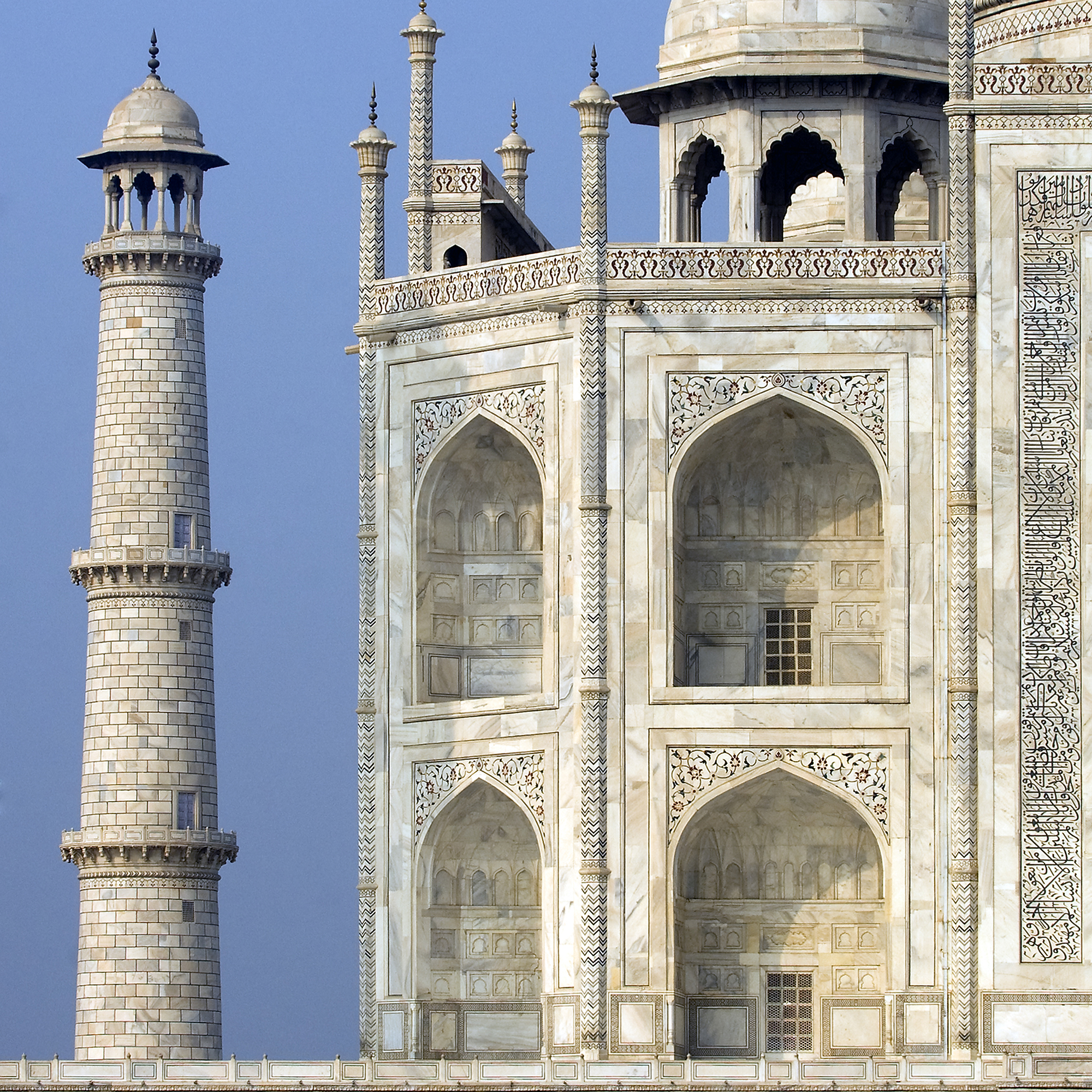ARTICLE
Taj Mahal, Agra
Scholars have argued that the visual and built elements of the Taj Mahal evoke elements from Islamic cosmology as well as Timurid cultural conventions. Its garden and waterways are meant to evoke the Quranic Garden of Paradise, while the main tomb structure at the northern end is derived from the Sufi interpretation of the Throne of God, or arsh placed at the head of the garden. The placement of minarets on the corners is in keeping with Timurid funerary architecture, as exemplified in the Gur-e-Amir, the mausoleum of Timur in Samarkand. The tomb’s overall design also draws from that of the Humayun’s Tomb, which was similarly designed keeping Islamic cosmology and paradisiacal symbolism in mind.
Unlike most monuments in the subcontinent, the identity of a few artisans involved in the construction of the Taj Mahal is known. Apart from Shah Jahan himself, scholars have identified two other potential architects — Ustad Ahmad Lahori, who later designed the Red Fort and other structures in Shahjahanabad, and Mir Abd-ul Karim, who was particularly favoured by Jahangir, Shah Jahan’s father. The Shahjahannama claims that Karim, alongside another administrator, Makramat Khan, supervised the construction of the Taj Mahal. Some stone-cutters etched marks, motifs and names into stone slabs on the garden path and walls in the form of fish, flowers, numerals and stars. Names were inscribed in Devanagari and Persian scripts, most of them now indistinguishable from graffiti made by later visitors. The total number of people employed in the construction is unclear, with estimates based on European travellers’ accounts. Jean Baptiste Tavernier, the French gem merchant and traveller, who visited Agra in the early 1640s, claimed that around twenty thousand men were involved, while Sebastian Manrique, a Portuguese missionary who visited Agra in the mid-seventeenth century, claimed that a thousand men were employed every day. A widely believed story around the Taj Mahal is that Shah Jahan ordered the hands of workers involved in building the structure be cut off once construction was finished, so that they could not repeat the feat, but this finds no mention in any historical source and has been dismissed as apocryphal.
The details of funding for the conservation of the Taj Mahal are better documented than for most other South Asian monuments. While charitable endowments, in the form of a tax-free awqaf, were historically made by Mughal emperors, expanding British rule in the late eighteenth and early nineteenth century altered the local tax systems, drying up traditional sources of funding. In 1816, the pension allocated to the keepers of the Taj Mahal was suspended by the British government in the region and the mausoleum complex entered a period of neglect.
The conservation of the monument was revived in the nineteenth century with the arrival of Henry Hardy Cole, an archaeological surveyor. Cole was able to secure funds for the repair and maintenance of the monument by composing a photographic album of several monuments in the region, which was a format favoured for historical commentary among British and Indian elites at the time. Lord Curzon, during his tenure as the Viceroy of India between 1899 and 1905, took interest in the conservation of the Taj Mahal and initiated repair work at the structure under supervision of the government and the Archaeological Survey of India (ASI). In addition to overseeing repairs and installation of an illuminating lamp at the tomb, he is credited with ensuring that the area outside the tomb was cleared to create a buffer zone between the mausoleum grounds and the busy street of the adjacent Taj Ganj area.
The Taj Mahal came to occupy a place of pride in the anti-colonial movement, illustrating the architectural grandeur of pre-British South Asia. Consequently, it became the subject of art and writing associated with the movement, such as Abanindranath Tagore’s painting The Passing of Shah Jahan (1902). In post-independence India, the Taj Mahal has been a flashpoint for cultural and political debates. In 2005, it was the subject of a polarised debate following its registration as a Waqf property. There is a widely held belief among those who identify with Hindu nationalism that the Taj Mahal was built after the destruction of a pre-Mughal Shiva temple, the Tejo Mahalaya. These claims were advanced by PN Oak in his book Taj Mahal: The True Story (1989). The author and his supporters have moved court over the years to establish this claim, but so far, it has been dismissed by the Supreme Court of India. The theory has also been rejected by historians and archeologists in the absence of verifiable proof to support the claim. In May 2022, a petition was filed in the Allahabad High Court to get ASI to open twenty locked rooms in the Taj Mahal, with the claimants arguing that the locked rooms contain Hindu idols and scriptures.
The monument has also been the subject of environmental concerns. By the 1970s, following the construction of an oil refinery in nearby Mathura by the Indian Oil Corporation, the white marble of the structure became noticeably discoloured due to deteriorating air quality, in particular, the presence of corrosive sulphur dioxide in the atmosphere. In 1982, the Government of India declared an area of 10,400 square kilometres around the Taj Mahal as the Taj Trapezium Zone, within which a ban on air-polluting industrial activity has been instituted.
The depleting water levels of the Yamuna have also been a source of concern. Since the Taj Mahal was constructed, Yamuna’s course has shifted slightly, and the river itself has shrunk due to damming activities. This has exposed more land between the mausoleum and the river, raising concerns that the dwindling groundwater might cause the wells and wooden components of the mausoleum’s foundation to crack if they remain dry for too long. In 2002, the Uttar Pradesh State Government inaugurated the Taj Corridor Project, which disregarded existing local and traditional uses of the Yamuna and sought to bring the riverfront areas and their residents into the tourism industry by constructing a promenade along the river, among other residential and commercial structures. Public opinion was against the possible negative effects of this plan, which would also have broken laws against construction too close to the Taj Mahal and the Agra Fort. The project was eventually scrapped.
The monument continues to have deep symbolic and cultural associations. It was given the status of a UNESCO World Heritage Site in 1983. As of writing, the structure is under the maintenance and supervision of ASI.
Bibliography
Ahmed, Hilal. “Secularising the ‘Secular’: Monumentalisation of the Taj Mahal in Postcolonial India.” Economic and Political Weekly, vol. 48, no. 50 (2013): 71–78. https://www.jstor.org/stable/24479048.
Asher, Catherine. The New Cambridge History of India: Architecture of Mughal India. Cambridge University Press, 2008.
Kavuri-Bauer, Santhi. Monumental Matters: The Power, Subjectivity, and Space of India’s Mughal Architecture. Durham and London: Duke University Press, 2011.
Koch, Ebba. The Complete Taj Mahal and the Riverfront Gardens of Agra. London: Thames & Hudson, 2006.
Malhotra, Raghu. “Explained: The Persistent Theory that Taj Mahal was a Hindu Temple Called ‘Tejo Mahalaya.” Indian Express, May 15, 2022. Accessed June 21, 2022. https://indianexpress.com/article/explained/taj-mahal-controversy-hindu-temple-tejo-mahalaya-7916684/.
Mehta, Archit. “Fact-Check: Did Shah Jahan Chop off the Hands of Taj Mahal Workers?” The Wire, December 24, 2021. Accessed June 21, 2022. https://thewire.in/politics/fact-check-did-shah-jahan-chop-off-the-hands-of-taj-mahal-workers.
News18. “On This Day in 2007: New 7 Wonders of the World Announced; Check Images,” July 7, 2021. Accessed June 21, 2022. https://www.news18.com/news/lifestyle/on-this-day-in-2007-new-7-wonders-of-the-world-announced-check-images-3933248.html.
Hindustan Times. “Open Rooms of Taj Mahal to Find Facts about Hindu Idols: Petition in High Court,” May 8, 2022. Accessed June 21, 2022. https://www.hindustantimes.com/india-news/open-rooms-of-taj-mahal-to-find-facts-about-hindu-idols-petition-in-high-court-101651982898057.html.
Times of India. “Taj Mahal Remains the Highest Revenue-generating Monument in India,” July 23, 2022. Accessed August 13, 2022. https://timesofindia.indiatimes.com/travel/travel-news/taj-mahal-remains-the-highest-revenue-generating-monument-in-india/articleshow/93065627.cms.
Sinha, Shashank Shekhar. “What Really Ails the Taj Mahal.” The Wire, July 8, 2018. Accessed August 13, 2022. https://thewire.in/urban/what-really-ails-the-taj-mahal.






